Statistical Bulletin Crime and Justice Series: Fire Statistics Scotland, 2010-11
Statistical information on the incidents attended by Scotland's fire and rescue services for 2010-11.
4. Commentary
This year the publication contains provisional data for 2010-11. These figures are still to be finalised but they provide a more timely aspect than was previously possible to publish. It is important to remember when using these figures that they are provisional and that they may be amended in future publications. This is especially true of casualties (see note 6.3.1 for revisions policy).
The figures for 2009-10 have been revised and the figures provided here supersede those in the previous publications, and should be used in the reporting of fire statistics for Scotland.
For all Scotland level tables, figures are provided to cover a minimum of ten years. At FRS level, the tables are only produced for the most current financial year. There are additional datasets available that provide trend figures for the key statistics at FRS level over ten years at: http://www.scotland.gov.uk/Topics/Statistics/Browse/Crime-Justice/Datasets/DatasetsFire
4.1 Total number of fires ( Tables 1 and 1a)
The total of all fires (primary, secondary and chimney fires) in Scotland for 2010-11 is 38,927, which is 1 per cent higher than the revised figure of 38,731 fires recorded in 2009-10. In 2010-11 primary fires accounted for 34 per cent (13,231) of the total number of fires, 62 per cent (24,162) were secondary fires and 4 per cent (1,534) were chimney fires.
The number of primary fires in 2010-11 was 13,231, a decrease of 6 per cent from the 2009-10 revised figure of 14,007. Within primary fires for 2010-11, the highest proportion were dwelling fires (48 per cent), followed by other buildings (21 per cent), fires in road vehicles (20 per cent) and other primary fires (10 per cent). The 2010-11 figures are the second lowest number of primary fires in the last ten years.
Between 2009-10 and 2010-11, secondary fires increased by 5 per cent to 24,162 and chimney fire figures decreased by 12 per cent to 1,534.
The total number of fires in 2010-11 (38,927) was the second lowest value in the last decade. However there have been some large changes within the categories of fires. The number of secondary fires in 2010-11 has decreased by 25 per cent from 2006-07. As secondary fires are the highest proportion of total fires, changes within this category will have a greater influence over the total fire figure for Scotland. This year there has been a 5 per cent increase in secondary fires that has contributed to the 1 per cent increase in all fires since 2009-10 (Chart 2).
Chart 2 - Fires by location, Scotland 2001-02 to 2010-111
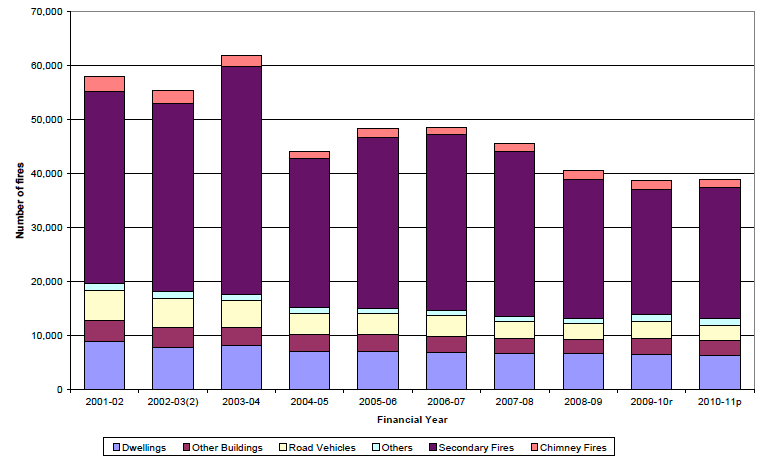
Notes:
p - provisional
r - revised
1 - with the exception of 2009-10 and 2010-11, figures for primary fires are based on sample data weighted to Fire and Rescue Service level
2 - does not include incidents that occurred during national industrial action in November 2002, January 2003 and February 2003
4.2 Casualties by location ( Tables 2, 2a, 3 & 3a)
In Scotland in 2010-11 the provisional figure for fatal casualties from primary fires was 47 - a decrease of 12 from 2009-10. The figure for 2010-11 was the second lowest in the reported ten year period. The provisional figure for fatal fire casualties in dwellings for 2010-11 was 40, of these 38 were in accidental dwelling fires. The figures for fatal casualties from dwelling fires and accidental dwelling fires in 2010-11 were again the second lowest for this reported ten year period.
The figures are provisional and can change due to the findings of fire investigations etc. The 2009-10 provisional figure published last year has been revised twice since this publication - it was first published provisionally at 59, revised to 60 in the last publication in June 2011 and now has returned to 59.
The provisional figure for non-fatal casualties in 2010-11 was 1,294. This is an increase of 7 per cent on the revised 2009-10 figure of 1,212. The highest number of non-fatal casualties in 2010-11 occurred in dwellings fires (1,108 or 86 per cent), 945 of which occurred in accidental dwelling fires. The number of non-fatal casualties (excluding precautionary check-ups) in primary fires was 1,077, an increase of 14 per cent from 2009-10. (See paragraph 6.3.3 for an explanation on the reporting of non-fatal casualties).
The provisional rate for fatal casualties was 7.2 per 1,000 accidental dwelling fires in 2010-11. This is the second lowest rate over the reported ten year period for this publication (Chart 3). This year the rate is lower than the ten year average of 8.9. (The ten year average shows that nearly 9 people die for every thousand accidental dwelling fires in Scotland.)
Chart 3 - Fatal casualties rate per 1000 accidental dwelling fires, Scotland, 2001-02 to 2010-11p,1
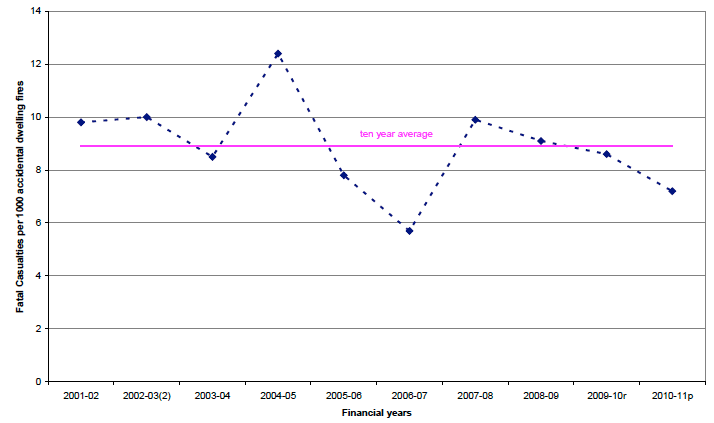
Notes
p - provisional
r - revised
1 - with the exception of 2009-10 and 2010-11, figures for accidental dwelling fires are based on sample data weighted to Fire and Rescue Service level
2 - does not include incidents that occurred during national industrial action in November 2002, January 2003 and February 2003
4.3 False alarms ( Tables 4, 4a, 4b & 4c)
In 2010-11, the total of false alarms attended by the FRS in Scotland constituted 50,056 incidents. Of these 97 per cent were fire false alarms (48,752) and the other 3 per cent were special service false alarms (1,304).
Of false fire alarms, 34,517 (71 per cent) were due to apparatus failure. Malicious false fire alarms accounted for 5 per cent (2,670) of total false fire alarms. This is the lowest figure for malicious false fire alarms reported in the last decade. The remaining 11,565 (24 per cent) false fire alarms were raised with good intent.
Only 7 per cent of the false special service alarms were considered malicious and the rest (93 per cent) were raised with good intent.
4.4 Special services ( Tables 5, 5a, 5b & 5c)
In 2010-11, the total number of special service incidents attended by FRSs was 11,297. The highest proportion of these incidents were flooding incidents at 22 per cent (2,471), closely followed by road traffic collisions (where a fire did not occur) at 21 per cent (2,401). In half of all road traffic collisions in Scotland in 2010-11, the FRS attended to make the vehicle safe (1,199) and 30 per cent of incidents required extrication of persons from vehicles (731). For flooding incidents 32 per cent were to isolate water supplies (786) and 28 per cent were 'flooding other' (702).
4.5 Building fires ( Tables 6 & 6a)
In 2010-11, the total of 9,173 building fires were recorded in Scotland, this is a decrease of 4 per cent from 2009-10 (9,568 building fires). This is the lowest value for over a decade, 69 per cent of building fires occurred in dwellings.
The 'Other building' sub-categories have changed since 2008-09 and reporting is now on these new categories. Of the 2,837 'Other buildings' fires, 21 per cent, were 'Other residential', 14 per cent were 'Private garages, sheds, etc' and 12 per cent were 'Industrial'.
4.6 Outdoor fires ( Tables 7& 7a)
Primary outdoor fires have decreased by 9 per cent for 2010-11 (4,058) compared to 2009-10 (4,439). For the last ten years road vehicle fires have represented the largest proportion of fires in this category, accounting for 66 per cent of all primary outdoor fires in 2010-11. Of the 2,685 vehicle fires in 2010-11, 53 per cent occurred in cars (not abandoned), 18 per cent occurred in abandoned vehicles and the rest occurred in other types of road vehicles (non-cars) (29 per cent).
The number of secondary outdoor fires for 2010-11 has increased by 5 per cent from 2009-10 to 24,162. The most common category in secondary outdoor fires was refuse fires. The trend data has been affected by changes in the recording system: previously there were only 6 sub-categories of secondary fires and now there are over 100 (see paragraph 6.3.4). This has led to a reduction in the reporting of refuse fires as they are now spread amongst the new classifications, although refuse fires still account for 46 per cent of all outdoor secondary fires in 2010-11.
The number of refuse fires in 2010-11 was 11,060, a decrease of 6 per cent from 2009-10 (11,818). Half of the refuse fire where loose refuse/ rubbish tip fires, 42 per cent were small /rubbish container fires ( e.g. wheelie bins) and 8 per cent were large/rubbish containers ( e.g. skips).
The number of grass fires increased by 1,608 between 2009-10 and 2010-11 which has contributed to the 5 per cent increase in secondary outdoor fires.
4.7 Fire casualty numbers and rates ( Tables 8, 8a, 9, 9a,9b, 9c, 9d, 10, 1 0a, 10b, 10c, 10d,11, 11a, 11b, 11c, 11d, 12, 12a,12b, 12c, & 12d )
In 2010-11, the provisional figure for fatal casualties in fires was 47. The fatal casualty rate per million population for Scotland was 9.0. This is the joint lowest rate (with 2006-07) in the last ten years. In 2010-11, 33 males died in fires compared to 14 females. The 2010-11 rate of fatal casualties per million population for males was 13.0 whereas females was 5.2. Chart 4 showing that males are more likely to die in a fire than females and the 2010-11 figures are consistent with the trend over the last decade.
Chart 4 - Non- FRS personnel fire casualty rates per million population from primary fires - by gender, Scotland, 2001-02 to 2010-11
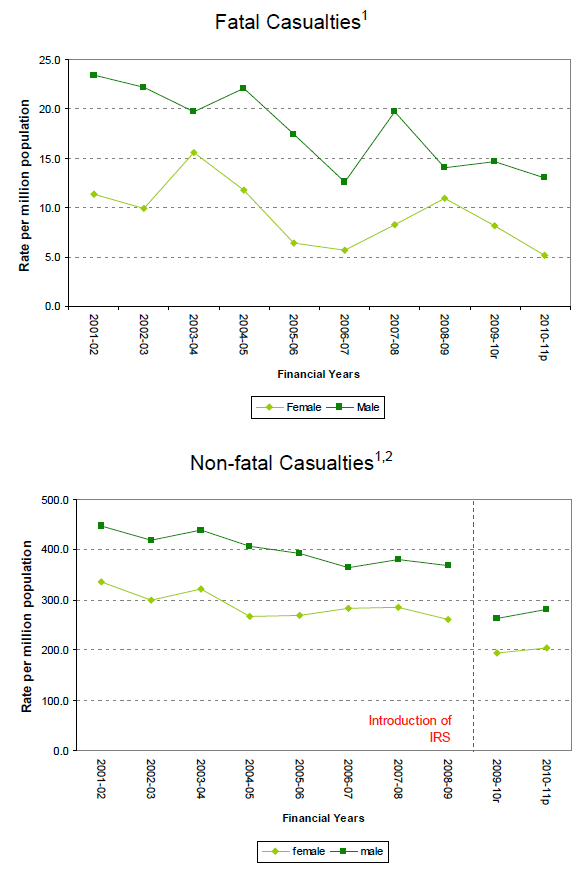
Fatal Casualties 1
Non-fatal Casualties 1,2
Notes for Chart 4
p - provisional
r - revised
1 - refers to persons who are not members of the fire and rescue service
2- there has been a change in the recording of non-fatal casualties and 2009-10 and beyond can no longer be compared to previous years - see paragraph 6.3.3 iii
In 2010-11, there were provisionally 1,294 non-fatal casualties in primary fires. The non-fatal casualty rate was 247.8 casualties per million population for Scotland. If the 27 FRS personnel non-fatal casualties are removed from this figure , the number for members of public (Non- FRS) who were non-fatal casualties was 1,267 and the casualty rate for Scotland is 242.6 casualties per million population.
In 2010-11, there were 712 males who were non-fatal fire casualties compared with 553 females (this excludes FRS personnel figures). Males are more likely than females to be injured in a fire and this has been a consistent trend over the last decade. The rate of non-fatal casualties per million population for males was 281.4, whereas females were 205.4. (Chart 4).
There were 19 fatal casualties (40 per cent) in 2010-11 who were 'overcome by smoke, gas or fumes'. Similarly, this was the highest category for (non- FRS) non-fatal casualties at 41 per cent (523), followed by precautionary check ups at 17 per cent (214). Of these non-fatal casualties 516 members of the public were sent to hospital with slight injuries (41 per cent), 436 were given first aid at the scene (34 per cent), 214 were recommended precautionary checks (17 per cent) and 101 went to hospital with serious injuries (8 per cent).
Of the 47 fatal casualties in 2010-11, there were 21 in the 30-59 year group, followed by 20 in the over 60s age group. The rate of fatal casualties was 16.6 per million population in the over 60s age group, just under double the Scottish rate of 9.0, whereas the 30-59 age group was 9.9. Throughout the last ten years the over 60s age group has always had the highest rate of fatal casualties per million population. (Chart 5)
In 2010-11, the 30-59 year olds age range had the highest number of (non- FRS) non-fatal casualties with 569 (45 per cent), followed by the 60 and over age group with 313 (25 per cent). The age range of 17-29 year olds has the highest rate of non-fatal casualties at 302.2 casualties per million population. This age range has had the highest rate for injuries for the last ten years (Chart 5).
Chart 5 - Non- FRS personnel fire casualty rates per million population from primary fires - by age range, Scotland, 2001-02 to 2010-11p
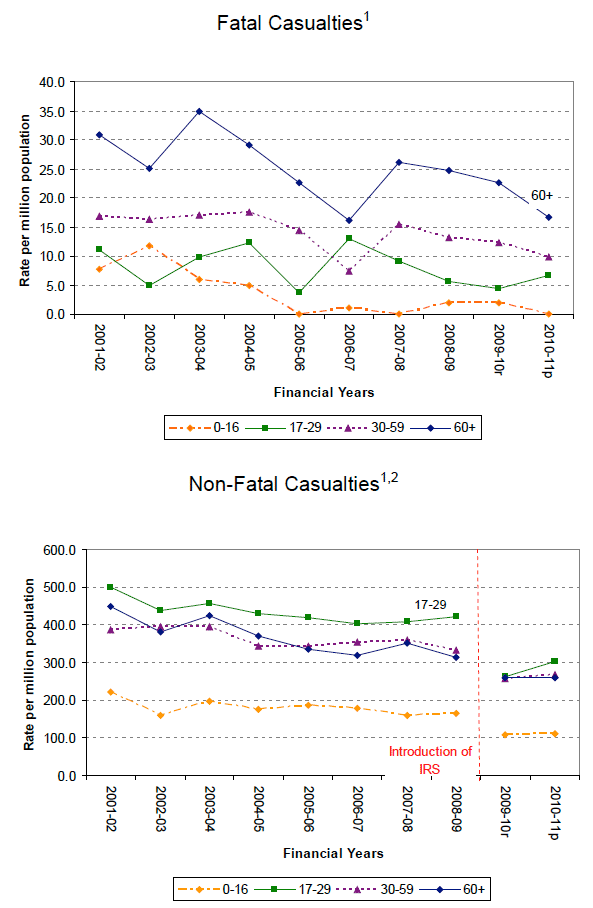
Fatal Casualties 1
Non-Fatal Casualties 1,2
p - provisional
r - revised
1 - refers to persons who are not members of the fire and rescue service
2 - there has been a change in the recording of non-fatal casualties and 2009-10 and beyond can no longer be compared to previous years - see paragraph 6.3.3 iii
4.8 Deliberate and accidental fires ( Tables 13, 14,15 & 15a)
In 2010-11, there were 9,152 primary fires reported as accidental compared to 4,079 that were considered deliberate: 69 and 31 per cent respectively. For 2010-11, the most common location for an accidental fire was in a dwelling (57 per cent), whereas the most common location for a deliberate fire was a road vehicle (31 per cent). Accidental dwelling fires for 2010-11 are at their lowest level in the last ten years at 5,254.
There were provisionally 43 fatal casualties in accidental primary fires and 4 in deliberate primary fires in 2010-11. In both accidental and deliberate fires most fatal casualties occurred in dwellings, 38 and 2 respectively .Fatal casualties from accidental primary fires are at their second lowest value and fatal casualties from deliberate fire are at their lowest value in the last ten years.
There were provisionally 1,068 non-fatal casualties in accidental primary fires and 226 in deliberate primary fires in 2010-11. Again the majority of non-fatal casualties occurred in dwellings, 945 in accidental dwelling fires (88 per cent) and 163 in deliberate dwelling fires (72 per cent).
More secondary fires are deliberate (89 per cent) compared with primary fires (31 per cent). In 2010-11, there were 21,591 deliberate secondary fires compared to 2,571 accidental secondary fires. The majority of deliberate secondary fires involved refuse (47 per cent), followed by grassland (34 per cent). Within accidental secondary fires grasslands and refuse were the most common types of fire, 46 and 35 per cent respectively.
4.9 Smoke alarms ( Tables 16 & 16a)
The presence of smoke alarms has always been reported in FDR1 data, but with the introduction of IRS a new category has been included i.e. 'Don't know if smoke alarm was present' (see paragraph 6.3.4) - thus affecting the comparability of these statistics before 2009-10. For the 2010-11, 2,228 dwelling fires (36 per cent) occurred where a smoke alarm was absent and there were 147 dwelling fires (2 per cent) where it was not known if a smoke alarm was present.
In 41 per cent of primary dwelling fires in 2010-11 there was a smoke alarm present, that operated and raised the alarm. (Chart 6)
In 2010-11, 8 of the provisional fatal casualties occurred in dwelling fires where there were no smoke alarms (20 per cent). For the provisional non-fatal casualties for 2010-11, 346 were in a dwelling fire were no smoke alarm was present (31 per cent).
Chart 6 - Primary fires in dwellings by smoke alarm presence and operation,
Scotland - 2010-111, 2
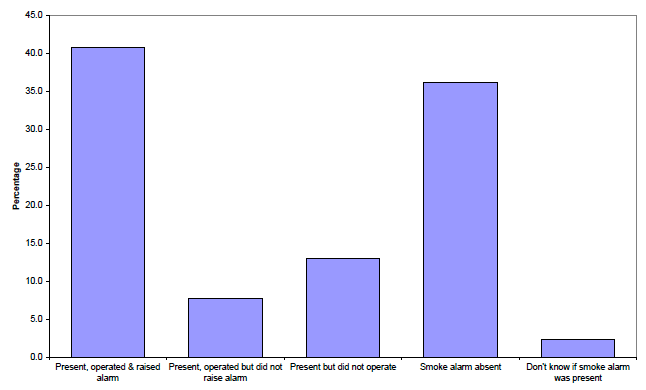
Notes
1 - includes caravans and houseboats used solely as a permanent dwelling
2 - there has been a change in the recording of smoke alarms - see paragraph 6.3.4 iv for details
4.10 Causes of fires ( Tables 17, 17a,18, 19, 19a & 19b)
In 2010-11, the most common cause of primary dwelling fires was 'Misuse of equipment or appliances' (40 per cent, 2,539 dwelling fires) followed by 'Deliberate fires' (17 per cent, 1,082 dwelling fires) and then 'Careless handing of fire or hot substances', (10 per cent, 607 dwelling fires). Deliberate dwelling fires were at a ten year low in 2010-11. (Chart 7)
Although deliberate fires in 'Other buildings' were also at a ten year low, it was still the highest cause of fire at 29 per cent (815).
Chart 7 - Main causes of fires in dwellings (excluding 'others' as a cause), 2001-02 to 2010-11p, Scotland1,3
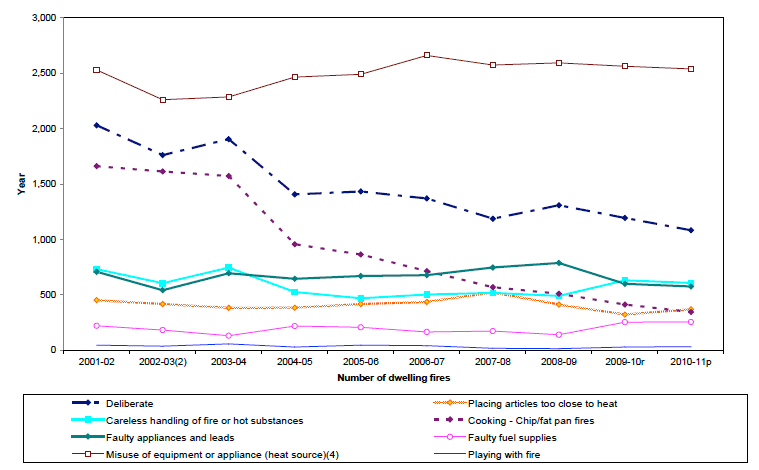
Notes
p - provisional
r - revised
1 - with the exception of 2009-10 and 2010-11, figures for primary fires are based on sample data weighted to Fire and Rescue Service level
2 - does not include incidents that occurred during national industrial action in November 2002, January 2003 and February 2003
3 - includes caravans and houseboats used solely as a permanent dwelling
4 - Under IRS, the category for "Misuse of equipment or appliances" includes incidents which have been recorded as "Other cooking" (a new category introduced with IRS). It is believed that the majority of these incidents were previously recorded as the misuse of cooking appliances under the FDR1 collection
In 2010-11, 42 per cent of fatal casualties in accidental dwelling fires arose due to careless handling of fire and hot substances (16 of 38 fatal casualties). Whereas smoker's material and matches were the main source of ignition in 39 per cent (15 of 38) of fatal casualties.
The main cause of non-fatal casualties from accidental dwelling fires was misuse of equipment or appliances (35 per cent). Whereas cooking appliances accounted for 54 per cent (515) of the main source of ignition for accidental fires where a non-fatal casualty occurred.
With the introduction of IRS in 2009, FRSs started to record where there was the suspected influence of alcohol/drugs involved in a fire. In 2010-11 there were 16 per cent (835) of accidental dwelling fires where impairment due to suspected alcohol and /or drugs use was a contributory factor to the fire. This was a decrease of 1 per cent from 2009-10 (17 per cent).
It should be noted if a fire is suspected to have been influenced by impairment due to alcohol and/or drugs, this does not imply that all casualties were under the influence of alcohol and/or drugs.
In these type of accidental dwelling fires in 2010-11, there were 11 fatal casualties (29 per cent) and 248 non-fatal casualties (26 per cent). These figures decreased from 2010-11, were there were 18 fatal casualties (39 per cent) and 302 non-fatal casualties (34 per cent).
4.11 Spread of fire ( Table 20)
With changes to recording through the IRS system, a new category 'smoke and/or heat damage only' has been included in spread of fire (see paragraph 6.3.4 for details), which has affected the long term trend data. For 2010-11, 40 per cent (2,550) of fires in dwellings were reported with smoke and heat damage only. Of the 60 per cent of incidents in dwellings where flames were reported (3,786), most of the fires were 'confined to the item first ignited' (41 per cent).
4.12 Time of call to Fire and Rescue Services ( Tables 21, 21a& 22)
For 2010-11 the number of call outs to primary fires (over 700 an hour) generally peaked between mid-afternoon and late evening (4 pm to 9 pm). Scotland's busiest hour for call outs to primary fires was 5 pm to 5:59 pm. (897 or 7 per cent).
Call outs to dwelling fires peaked between 4 pm and 7 pm in 2010-11. Other building fires were more likely to occur between 5 pm and 8 pm, whereas primary outdoor fires generally occurred between 5 pm and midnight. (Chart 8)
The rate of non-fatal casualties per 1,000 dwelling fires was at it lowest between 1 pm to 6 pm. Whereas the rate of fatal casualties per 1,000 dwelling peaked between 2 am and 7 am in 2010-11. (Chart 9).
The numbers of dwelling fires were greater between mid-afternoon to late evening but the rate of casualties per 1000 dwelling fires increased between late afternoon and mid-morning.
Chart 8 - Primary fires by location and time of call, Scotland, 2010-11p
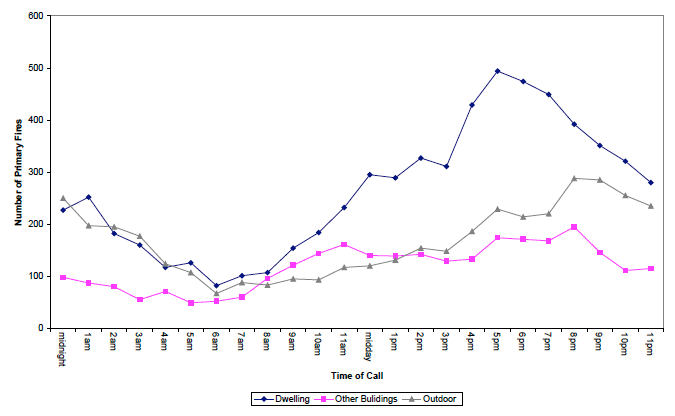
Chart 9 - Rate of fatal and non-fatal casualties per 1000 primary dwelling fires by time of call Scotland, 2010-11p
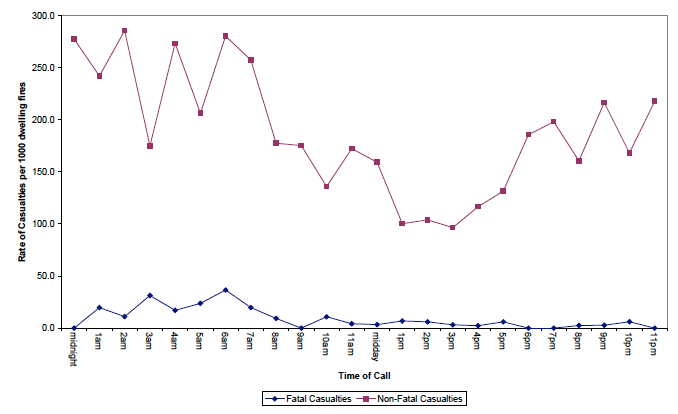
There is a problem
Thanks for your feedback